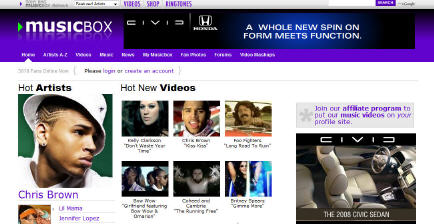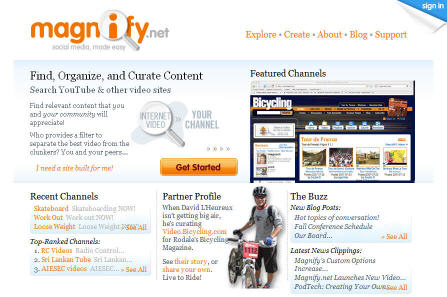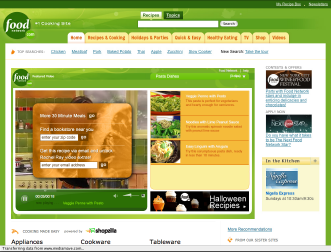-
Adap.tv Improves Broadband Video Ad Targeting with CPC Approach
As the broadband video world continues to coalesce around advertising as its primary business model, there is a flurry of companies seeking to improve the monetization process. As I've written before, this is critical work, because at some point the bloom will be off the broadband video rose if participants can't earn an attractive ROI.
Enter Adap.tv, which is addressing the ad monetization challenge. The company was founded last year and is based in San Mateo, CA. It is backed by Redpoint and Gemini and now has 20 employees.

CEO/co-founder Amir Ashkenazi recently gave me a run-down on Adap.tv's approach and progress. Amir was the founder of Shopping.com, which was acquired by eBay and he has brought together many former colleagues for his experienced management team.
Like its competitors, the heart of Adap.tv's model is its ad targeting and relevance engine. Adap.tv uses a "multi-disciplinary approach": analysis of the video/audio (context, metadata, etc.), analysis of the ad (keyword submission, etc.) and analysis of the user (demographics, location, etc.). This data is then fed to a matching engine to pair ads with the most relevant video. Over time the system optimizes based on actual click behavior.
Adap.tv is highly focused on overlays (Amir believes this will be the "de-facto standard" soon), and provides a series of customizable templates for advertisers (see below Kayak overlay). It is also positioning itself as a cost-per-click model, so there's no fixed cost to advertisers. In fact, advertisers can power Adap.tv ads using the same keyword feeds they use for their keyword campaigns.

So far publishers have been responsive to the CPC model because they see overlays as opening up a lot of untapped inventory. Obviously implementing overlays needs to be done judiciously or the viewer experience will become cluttered and broken. Amir believes the whole broadband video ad model will move to CPC over time as advertisers become more sophisticated and focused on performance. This Google-like model would be very good news for advertisers, but would be a brave new world for traditional broadcast and cable networks long accustomed to CPM approaches in their traditional businesses.
While I think a more performance-based broadband ad environment would be welcome, I continue to believe a CPC/overlay approaches will ultimately co-exist with CPM/pre-rolls. There's a lot of interest in overlays, yet there are too many great 15 and 30 second TV spots not be re-used online and the CPMs are way too rich for big branded content providers to walk away from.
Other companies that are in the contextual analysis and/or overlay space include: ScanScout, Digitalsmiths (note: a VideoNuze sponsor), YuMe, blinkx, VideoEgg, YouTube, Brightcove, AdBrite, Viddler (which TechCrunch just wrote about yesterday) and others I'm sure I'm missing or are yet to surface.
Categories: Advertising, Startups, Technology
Topics: Adap.TV, AdBrite, Blinkx, Brightcove, Digitalsmiths, ScanScout, Viddler, VideoEgg, YouTube, YuMe
-
Exclusive Brightcove Update with Jeremy Allaire

Yesterday I did an hour-long briefing with Jeremy Allaire, Brightcove's CEO/founder at their Cambridge offices.
If I were to make a list of the 5 questions I've been asked most frequently over the last two years, "What do you think about Brightcove?" would easily be on the list. Certainly a lot of the attention Brightcove has generated relates to its fund-raising leadership. Through three rounds, the company has raised $82 million, including the monster $59.5 million C round closed in January 2007.
By my count the only pure-play, private broadband video company that has raised more is Hulu, which raised $100M in one round from Providence Equity. But Hulu's probably not a fair comparison given that NBC and News Corp are the company's primary owners and are contributing exclusive content. (btw, if anyone has a different take on who's raised more, please leave a comment)
So this briefing was a great opportunity to get a first-hand update and also channel many of the follow-on questions I've been asked about Brightcove. (Full disclaimer, Brightcove is a VideoNuze sponsor.) Jeremy also shared some new stats with me that haven't been disclosed before.
(To read the full update on Brightcove's positioning, Broadband Video Market and Advertising, Syndication and Going Forward, click here)
Categories: Technology
Topics: Brightcove
-
Exclusive Brightcove Update with Jeremy Allaire

Yesterday I did an hour-long briefing with Jeremy Allaire, Brightcove's CEO/founder at their Cambridge offices.
Background
If I were to make a list of the 5 questions I've been asked most frequently over the last two years, "What do you think about Brightcove?" would easily be on the list. Certainly a lot of the attention Brightcove has generated relates to its fund-raising leadership. Through three rounds, the company has raised $82 million, including the monster $59.5 million C round closed in January 2007.
By my count the only pure-play, private broadband video company that has raised more is Hulu, which raised $100M in one round from Providence Equity. But Hulu's probably not a fair comparison given that NBC and News Corp are the company's primary owners and are contributing exclusive content. (btw, if anyone has a different take on who's raised more, please leave a comment)
So this briefing was a great opportunity to get a first-hand update and also channel many of the follow-on questions I've been asked about Brightcove. (Full disclaimer, Brightcove is a VideoNuze sponsor.) Jeremy also shared some new stats with me that haven't been disclosed before.
Positioning
Brightcove's positioning has shifted around in the 18 months since its official launch causing many industry tongues to wag.
Jeremy explained that in the summer of 2007 the company did a candid assessment of its competitive standing across areas in which it was involved. While his original vision included a consumer-facing destination site (named Brightcove TV), this assessment concluded that with YouTube's dominance, Brightcove's goal to be number 1 in that business was unlikely to ever materialize. Further, the potential for conflict with its own media customers had become real. So though Brightcove TV had 8 million unique visitors in August, 2007 according to comScore (making it the number 5 player in that space), Brightcove decided to de-emphasize it and reduce investment spending on it to zero. As a result, Brightcove TV now functions mainly as a showcase site.
The company narrowed its focus to its broadband media publishing and management platform, which Jeremy says is now used by 4,000 professional publishers (sample list here), which Brightcove thinks makes it number 1 among its competitors. These publishers operate 7,000 web sites with an estimated combined reach of 120 million unique visitors per month.
The platform business model includes an annual software licensing fee with upside revenue based on the customers' usage. Jeremy denied that the company is taking ad revenue shares in lieu of platform fees, a rumor that has persistently circulated in the market. Brightcove has also continued to build out a professional support team serving the gamut of design, support, integration and customization required by customers.
Broadband Video Market and Advertising
From Jeremy's vantage point the major media companies Brightcove is serving are aggressively focused on building out their direct-to-consumer broadband video destinations, and only recently have they begun also considering syndication. Brightcove's customers' business models skew overwhelmingly in favor of advertising support, with only negligible interest being shown in Brightcove's commerce capabilities.
On this point Jeremy and I have been in agreement for a long time - the macro factors driving ad-supported broadband businesses are very strong, while those driving paid downloads continue to be challenged. The key catalysts for paid models will be mass connections from broadband to TVs, better portability and improved competitiveness with the DVD platform. In the longer-term all of these will no doubt fall into place, however, for as far as the eye can see, broadband is going to remain an ad-dominated industry.
The follow-up question of course is, what kind of advertising will predominate? Brightcove supports a range of options and Jeremy said that recently interest in overlays is running very high, though 15 second pre and mid-rolls are still used by 99% of its customers today. There's a lot of planning or rolling out of overlays coming shortly by Brightcove customers. People.com was shown as an example of a hybrid pre/mid-roll and overlay model that Jeremy thinks will become more prevalent.
Syndication
Brightcove is also starting to see heightened interest in syndication, and the company offers a set of tools to support it. One example Jeremy showed which I haven't followed is Sony BMG's "MusicBox" service, which offers an array of syndication options. Sony BMG demonstrates that for sites serious about syndication, it's about far more than moving video files around to third parties. Of course the goals of syndication are still to proliferate the content and brand to drive new revenues from far-flung corners of the Internet, but the mechanisms for optimizing this can be quite involved. There's integration of players, advertising, widgets and more. I've been very bullish on syndication for a while, and the actions by Hulu and CBS's Audience Network to distribute their content show real signs of life in the syndication model.
Going Forward
Not surprisingly, Jeremy's extremely bullish on broadband's future growth and sees opportunities galore to grow Brightcove's revenues by deepening its penetration of existing customers, driving more international business, especially in Asia, and expanding its fledgling presence in the enterprise/government sectors, where there's also been a lot of recent interest.
Regarding competition, Jeremy says Brightcove still sees internal development as an alternative being considered by some major media companies, though to a lesser and lesser extent recently. He also volunteered that both Maven and thePlatform are two companies Brightcove sees most often competing for deals. When asked what differentiates Brightcove, Jeremy cites product quality, ease-of-use, customer/market leadership, quality of its people and R&D. On this last point, he believes Brightcove's relatively deep pockets have helped it maintain a far more aggressive R&D budget, which grew by 300% this year.
Key upcoming priorities include launching "Brightcove Show", its new HD initiative, "Aftermix", its mash-up feature, which just finished up its beta test, multimedia capabilities (photos and audio) and enabling a slew of social/sharing features.
I couldn't resist asking Jeremy about Brightcove's last round valuation rumored to be north of $200 million. I've heard much skepticism in the market that the Brightcove's platform-centric strategy does not justify this lofty figure.
Jeremy's response is that based on the company's current revenue and recent growth trajectory, it has "grown into" its valuation and that its multiple is comparable to others he's aware of. His main objective is building a "significant global business" and if that's accomplished then there will be numerous options open for what ultimately happens with the company. He wouldn't comment on M&A, IPO or other potential exits, only saying that he feels no pressure from his investors to liquify their positions any time soon.
To achieve his global ambition, Jeremy says he's focused primarily on what actions Brightcove needs to make to dramatically scale the business, which he thinks can drive a real premium for Brightcove's valuation. To the extent that broadband remains mainly an ad-supported business, I think Jeremy correctly understands that scale - in customers, streams, usage, geographic reach, etc. - are absolutely central to success. When asked the classic "what keeps him up at night?", he cites as his chief source of insomnia the challenge of building out every part of the organization to support his goal of massive scale.
As Brightcove continues to evolve and grow, one thing is for certain - all eyes in the broadband industry will be watching its progress.
Categories: Technology
Topics: Brightcove, CBS, Hulu, Maven, Providence Equity, Sony BMG, thePlatform
-
Magnify.net: A Long Tail Matchmaker
 Yesterday I had a chance to catch up with Steve Rosenbaum, CEO and Co-Founder of Magnify.net.
Yesterday I had a chance to catch up with Steve Rosenbaum, CEO and Co-Founder of Magnify.net.One of the things I really enjoy about being an analyst in the burgeoning broadband video industry is getting first-hand exposure to all the clever innovation that's going on. I find it endlessly fascinating to hear directly from entrepreneurs on the front lines where the kernel of their idea came from which led to their business plan. A user experience issue? A technology deficiency? A business model flaw? Over the years I've heard many stories. Some kernels have real weight, while some don't quite resonate for me.
Magnify.net falls into the former category. My read is that this is a company trying to solve a real problem with a very clever solution and the right "corporate attitude" to make it a likely winner.
Magnify is actually solving a number of real problems, many of which relate to the highly distributed or "Long Tail" nature of the Internet and broadband video. First is that while consumers love broadband video, finding what they want is problematic. Novelty quickly turns to frustration when rummaging through big video sharing sites to find something relevant. No matter how much users want choice, some level of editorial or "curation" is essential to optimize their experience.
Magnify enables existing enthusiast or vertical web sites (whether independent or major media) to obtain video from the best video sharing sites (YouTube, Metacafe, etc.) and coherently present a screened assortment to their users. The sites' use their editorial skills to sort the wheat from the chafe, with easy-to-use admin tools ensuring that no offending video slips through the cracks.
So the second problem Magnify solves is enabling thousands (17,500 and counting to be exact) of sites to provide quality video to their users without the hassle and expense of creating it themselves (the "matchmaker" role). These sites get 50% of the revenue from the ads Magnify sells around the video (or they can keep up to 50% of the inventory to sell themselves), leveraging their audience and subject matter expertise. Incorporating video into web sites is becoming online table stakes. I agree with Steve, in the years ahead, sites without video are going to look "charming".
The only real hole I can find in Magnify's model is that it doesn't currently compensate the content creators themselves (a la Revver for example). However I'd expect that to change as creators upload directly to Magnify and the company's network and traffic builds out over time.
Lastly, I like Steve's attitude. He views the market as an incredibly expanding pie, and not "winner take all." As a result, while there are others who touch on Magnify's space (Brightcove, ROO, VideoEgg, Ning, KickApps, etc.), he's less concerned about competition per se and matching feature-for-feature, but rather on responding to the needs and wants expressed directly by their own user base. Companies that do this ultimately win, regardless of competition.
The Magnify story plays into a number of areas I follow closely - the changing role and power of video distributors, the continued "nichification" of video, the challenge of video discovery and the reliance on ads, not subscription fees. To the extent that their approach succeeds it will further morph traditional video models. For a 10 person company that's only done an angel round, they've accomplished a lot in addressing genuine Long Tail issues in the broadband video industry. (Btw, TechCrunch has 2 great reviews, here and here).
Categories: Aggregators, Indie Video, Startups, UGC, Video Sharing
Topics: Brightcove, KickApps, Magnify.net, Ning, ROO, VideoEgg
-
Maven Moves the Broadband Video Ad Market Forward
Maven Networks got a lot of ink today with 2 announcements, first the launch of a new broadband ad platform and the second, the launch of a new industry collaboration dubbed the "Internet TV Advertising Forum." These have been in the works for a while and Maven gave me a heads up on both over the summer.
The Ad Forum is noteworthy, as it appears to be a genuine "good guy" effort to move the whole industry forward in optimizing the ad model. Ten companies signed on for launch, including heavies like Scripps, Fox News, Oglivy, TV Guide, Microsoft, DoubleClick and 24/7.
I caught up by phone with Kristen Fergason, Maven's VP of Marketing to learn more. First, the Forum is completely open to everyone. Though initially underwritten by Maven, over time it will probably take on more of a "dues-paying" model. And to show that "open" really does mean open, I asked what happens if competitors like Brightcove for example, wanted in? Her reply: "we'd happily accept them".
The forum is mean to bring together agencies, content providers and vendors to build consensus about how to move past the market's current reliance on pre-rolls. Kristen said industry players have been "chomping at the bit" to get involved and Maven received 40 applications today alone. Importantly, the Forum is meant to augment IAB initiatives, not compete with them. The Forum will run focus groups and collect research based on ideas generated by Forum members to see what works and what doesn't. Results will be available to everyone.
Maven believes that a "rising tide lifts all ships", but because its ad platform is ready now, it will benefit disproportionately. That's where today's other announcement comes in. The demo I saw shows how new ad units (videos, overlays, banners, etc.) can be dynamically inserted, not just at the beginning of the video, but throughout. The result is that a lot of new inventory is available. The below graphic shows "cue points" for manual insertion, but an algorithm can also be used to insert based on what the system knows about things like clip length, average user session time, click-thru, etc. Note I didn't see this feature in action, so I can't say for sure how well it actually works.
 There's also pretty neat telescoping transaction capability as shown below, which allows the content provider or advertiser to collect specific user information. The video resumes when the user is done.
There's also pretty neat telescoping transaction capability as shown below, which allows the content provider or advertiser to collect specific user information. The video resumes when the user is done. The ad platform looks like a solid entry and when taken together with other myriad ad initiatives in the market, everything suggests that we may actually see life beyond pre-rolls. Hallelujah.
The ad platform looks like a solid entry and when taken together with other myriad ad initiatives in the market, everything suggests that we may actually see life beyond pre-rolls. Hallelujah.Categories: Advertising, Technology
Topics: 24/7, Brightcove, DoubleClick, Fox News, Maven, Microsoft, Oglivy, Scripps, TV Guide
-
Video Syndication Activity Builds
 News earlier this week that Fox Entertainment Group would be working with Brightcove to ramp up its syndication efforts adds to the drumbeat around this trend that was already pretty steady.Six months ago in my December, 2006 e-newsletter, "7 Broadband Video Trends for 2007", I identified broadband video syndication as important going into 2007. Back then I noted that "Syndication is the handmaiden of the ad-supported broadband video business model. Successful online advertising requires scale and targeting. Syndication provides both." I think we're seeing that play out.Whether the NBC-News Corp JV, CBS Interactive Audience Network, FEG deal, or countless others I've heard will be announced soon, they all point to same underlying fundamentals. Producing high-quality video is expensive. Content providers want to maximize their ROIs. So they want their content in as many places as possible to aggregate as large an audience as they can, so they can harness online advertising's potential. While none of this is a surprise by online standards, it is a departure from the traditional video models of tight control, limited distribution and exclusive deals.It's very promising to see the how much progress is being made so quickly to evolve to Internet-centric distribution approaches. More evidence that the media industry's future will be quite different than its past.
News earlier this week that Fox Entertainment Group would be working with Brightcove to ramp up its syndication efforts adds to the drumbeat around this trend that was already pretty steady.Six months ago in my December, 2006 e-newsletter, "7 Broadband Video Trends for 2007", I identified broadband video syndication as important going into 2007. Back then I noted that "Syndication is the handmaiden of the ad-supported broadband video business model. Successful online advertising requires scale and targeting. Syndication provides both." I think we're seeing that play out.Whether the NBC-News Corp JV, CBS Interactive Audience Network, FEG deal, or countless others I've heard will be announced soon, they all point to same underlying fundamentals. Producing high-quality video is expensive. Content providers want to maximize their ROIs. So they want their content in as many places as possible to aggregate as large an audience as they can, so they can harness online advertising's potential. While none of this is a surprise by online standards, it is a departure from the traditional video models of tight control, limited distribution and exclusive deals.It's very promising to see the how much progress is being made so quickly to evolve to Internet-centric distribution approaches. More evidence that the media industry's future will be quite different than its past.Categories: Advertising, Partnerships
Topics: Brightcove, FOX, Hulu, NBC, News Corp
-
CBS Announcement is More Great Fodder for Upcoming NAB Super Session
Yesterday’s announcement from CBS that it has formed the CBS Interactive Audience Network, and partnered with AOL, Microsoft, CNET, Comcast, Joost, Bebo, Brightcove, Netvibes, Sling Media and Veoh provides even more discussion material for the Super Session panel I’m moderating, which is coming up on Tuesday, April 17th at NAB 2007 (“The Revolutionizing Impact of Broadband Video”).
I’m always a little reluctant to use a word like “revolutionizing”, as it just feels a bit hyperbolic. Yet, what CBS announced yesterday, in combination with the NBC-News Corp JV announcement a few weeks ago sure does seem to signal that these networks themselves are willing to take new risks and be much more opportunistic with how their prized programs get to audiences’ homes. I give these companies all a lot of credit – they are demonstrating a willingness to challenge their existing (and longstanding) business models though the economics and potential of these new models are not yet clear.We’ll be getting into all of this and more at NAB – come join us!Categories: Broadcasters, Partnerships
Topics: AOL, Bebo, Brightcove, CBS, CBS Interactive Audience Network, CNET, Comcast, Joost, Microsoft, Netvibes, Sling Media, Veoh
Posts for 'Brightcove'
Previous |


